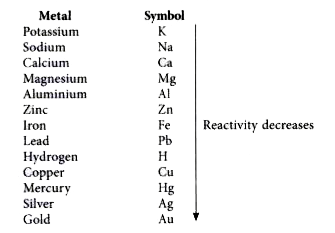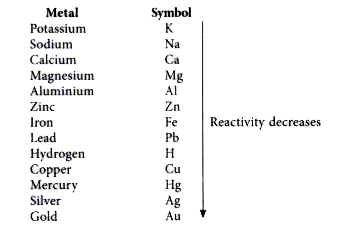If A,B,C,D,E,F,G,H,I,J and K represetnt metals in the decreasing order of their reactivity, which one of them is most likely to occur in a free state in nature?
K
Topper's Solved these Questions
- METALS AND NON-METALSBook:LAKHMIR SINGH & MANJIT KAURChapter:METALS AND NON-METALSExercise:Long Answer Type Question
Explore 1 Video
- METALS AND NON-METALSBook:LAKHMIR SINGH & MANJIT KAURChapter:METALS AND NON-METALSExercise:Short Answer Type Qustions
Explore 1 Video
- METALS AND NON-METALSBook:LAKHMIR SINGH & MANJIT KAURChapter:METALS AND NON-METALSExercise:Solved Problem
Explore 1 Video
- CHEMICAL REACTIONS AND EQUATIONS Book:LAKHMIR SINGH & MANJIT KAURChapter:CHEMICAL REACTIONS AND EQUATIONS Exercise:QUESTIONS BASED ON HIGH ORDER THINKING SKILLS (HOTS)
Explore 1 Video
- PERIODIC CLASSIFICATION OF ELEMENTSBook:LAKHMIR SINGH & MANJIT KAURChapter:PERIODIC CLASSIFICATION OF ELEMENTSExercise:VERY SHORT ANSWER TYPE
Explore 6 Videos
Similar Questions
If A, B, C, D are numbers in increasing order and D, B E are numbers in decreasing order , then which one of the following sequences need neither be in a decreasing nor in an increasing order? E, C, D (b) E, B , C (c) D, B, A (d) A, E ,C
View SolutionA, B, C, D, E, F, G, H and K are sitting around a circle facing the centre. B is fourth to the left of G, who is second to the right of C. F is fourth to the right of C and is second to the left of K. A is. fourth to the right of K. D is not an immediate neighbour of either K or B. H is third to the right of E.
Who is second to the right of K?
1) D
2) H
3) F
4) E
5) None of these
View Solution
Knowledge Check
Which one of the following metals occurs in nature in free state ?
AGoldBSodiumCAluminiumDCopperMost of the metals react chemically with other substances in one form or another. Few metals which do not react with common chemicals are called noble metals e.g., silver, gold, platinum. The rate of reaction with which metals react is not same for all the metals. The rate of reaction depends on the reactivity of metals. On the basis of their reactive nature, a series known as reactivity series has been drawn in which metals are arranged in decreasing order of their reactivity.

Which of the following represents the correct reactivity order of metals with water?ANa<Mg<zn<Fe<CuBNa>Zn>Fe>Mg>CuCNa>Mg>Fe>Zn>CuDNa>Mg>Zn>Fe>CuThe arrangement of metals in a vertical column in the decreasing order of their reactivities is called the reactivity series or activity series of metals. The most reactive metal is at the top position of the reactivity series. The least reactive metal is at the bottom of the reactivity series.
Hydrogen, though a non-metal, has been included in the activity series of metals only for comparison. Apart from it, the hydrogen atom also has tendency to lose its valence electron and form cation like the behaviour shown by metals. Thus,
H→H++e−
The most reactive metal isAPotassiumBbariumCsodiumDcalcium.
Identify, the elements with the following property and arrange them in increasing order of their reactivity.
(a) An element which is a solt and reactive metal.
(b) The metal which is an important constituent of limestone
(c) The metal which exists in liquid state at room temperature.
View SolutionStudy the information carefully and answer the questions given below.
(i) Eleven students A, B, C, D, E, F, G, H, I, J and K are sitting in a row of the class facing the teacher
(ii) D, Who is to the immediate left of F, is second to the right of C.
(iii) A, who is second to the right of E, Who is at one of the ends.
(iv) J is the immediate neighbour of A and B and third to the left of G.
(v) H is to the immediate left of D and third to the right of I.
Who is sitting in the middle of the row ?
View SolutionMost of the metals react chemically with other substances in one form or another. Few metals which do not react with common chemicals are called noble metals e.g., silver, gold, platinum. The rate of reaction with which metals react is not same for all the metals. The rate of reaction depends on the reactivity of metals. On the basis of their reactive nature, a series known as reactivity series has been drawn in which metals are arranged in decreasing order of their reactivity.

A strip of magnesium ribbon is added to some solutions of metal nitrates. Which metal nitrate will have no reaction with magnesium?
View SolutionA, B, C, D, E, F, G, H and K are sitting around a circle facing the centre. F is fourth to the right of A who is third to the right of B. K is fourth to the left of B and third to the right of D. C is third to the right of H. E is second to the left of G.
What is E's position with respect to B ? (a) Second to the left (b) Third to the right (c) Fourth to the right (d) Third to the left
View SolutionA, B, C, D, E, F, G, H and K are sitting around a circle facing the centre. F is fourth to the right of A who is third to the right of B. K is fourth to the left of B and third to the right of D. C is third to the right of H. E is second to the left of G.
Who is fourth to the left of G ?
View Solution